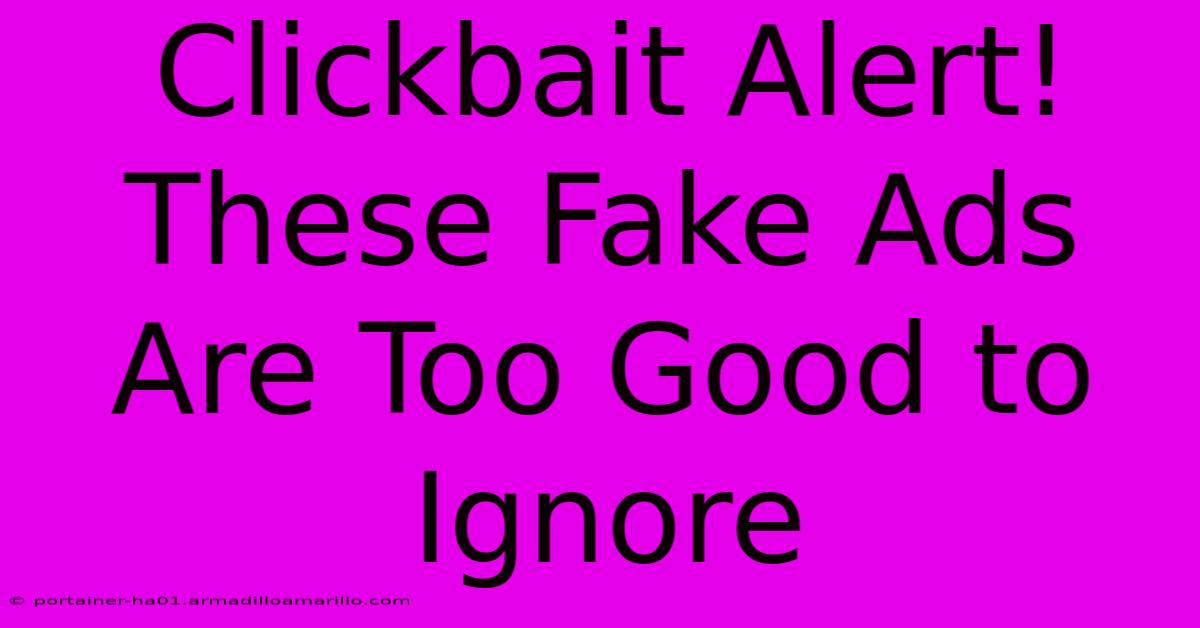Clickbait Alert! These Fake Ads Are Too Good To Ignore

Table of Contents
Clickbait Alert! These Fake Ads Are Too Good to Ignore
We've all been there. Scrolling through social media or browsing the web, and suddenly, an ad pops up that's too good to be true. A ridiculously cheap vacation, a miracle weight-loss product, or a guaranteed way to make millions from home. These are the hallmarks of clickbait ads, designed to lure you in with promises they can't deliver. This article will explore the tactics used in these deceptive ads and help you identify them before you fall victim.
The Allure of the Fake Ad
Why are these fake ads so effective? They prey on our desires and vulnerabilities. We all want things – financial freedom, better health, a dream vacation – and these ads exploit that. They tap into our emotions, using language like:
- "Limited-time offer!" Creating a sense of urgency.
- "You won't believe this!" Intriguing the reader with mystery.
- "Guaranteed results!" Offering false promises of success.
- "Lose weight fast!" Targeting our insecurities about our bodies.
Common Tactics Used in Fake Ads
These ads employ a variety of deceptive strategies:
-
Misleading Images: They often use stock photos or heavily edited images that bear little resemblance to reality. A picture of a luxurious villa might actually represent a cramped apartment.
-
Fake Testimonials: Phony testimonials and reviews are rampant, designed to create a false sense of legitimacy. Look for inconsistencies and grammatical errors – a red flag of fabrication.
-
Hidden Fees: The advertised price is often just the tip of the iceberg. Expect hidden shipping costs, subscription fees, or other charges that significantly inflate the final price.
-
Unrealistic Claims: If something sounds too good to be true, it probably is. Be wary of ads promising unrealistic results, especially in areas like weight loss, financial gain, or health improvements.
-
Urgency and Scarcity: Creating a sense of urgency, such as a limited-time offer or a dwindling supply, pressures you into making a hasty decision without proper consideration.
How to Spot a Fake Ad
Learning to identify these deceptive ads is crucial to protecting yourself:
-
Check the Website: Investigate the website linked in the ad. Look for poor website design, grammatical errors, and a lack of contact information. A legitimate business will have a professional-looking website with clear contact details.
-
Read Reviews: Don't just rely on the testimonials presented in the ad. Search for independent reviews on sites like Trustpilot or Yelp. See what other users have to say about the product or service.
-
Verify the Company: Try to find information about the company behind the ad. A quick Google search can often reveal negative reviews, complaints, or warnings about scams.
-
Be Skeptical of Guarantees: No product or service can guarantee miraculous results. Be wary of any ad that makes such promises.
-
Trust Your Gut: If something seems too good to be true, it probably is. Don't rush into making a decision. Take your time to research and verify the claims before committing to anything.
Conclusion: Don't Fall for the Clickbait
Clickbait ads are designed to exploit our vulnerabilities and desires. By understanding the tactics they use and learning to identify them, you can protect yourself from falling victim to these deceptive practices. Remember to always be skeptical, do your research, and trust your gut feeling. Don't let the allure of a "too good to be true" offer lead you into a disappointing – and potentially costly – experience. Your skepticism is your best defense against these online traps.

Thank you for visiting our website wich cover about Clickbait Alert! These Fake Ads Are Too Good To Ignore. We hope the information provided has been useful to you. Feel free to contact us if you have any questions or need further assistance. See you next time and dont miss to bookmark.
Featured Posts
-
Prepare To Be Enchanted Discover The Secret To Disney Magic Unveiled
Feb 07, 2025
-
Unveiling The Secret Vermeil Vs Gold Plated Which Reigns Supreme
Feb 07, 2025
-
Chromatic Symphony Of Baguette Hues A Sensory Exploration
Feb 07, 2025
-
Unveiled The Game Changing Dayton Vs Nevada Prediction You Cant Ignore
Feb 07, 2025
-
Unlock The Language Puzzle Sewed Or Sowed The Ultimate Answer
Feb 07, 2025
